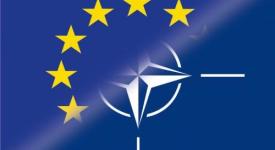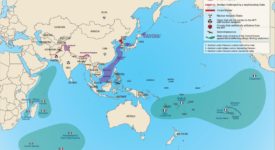The industrialisation of East Asia is increasing the link between the region’s prosperity and its dependence on the ability to secure undisputed access to energy and mineral deposits. Across the region, access to energy resources is hindered by political boundaries which cut across features of the natural terrain such as river-basins, watersheds and seas. Smaller states in the region, and this article focuses primarily on the ASEAN grouping, face competition from external powers such as China and Japan, as well as from one another, when attempting to secure access to external energy supplies.
Under-investment in Southeast Asia’s energy infrastructure, given the strong demand for energy in the region, is likely to contribute to high energy prices and threaten economic growth at the global level. Such a situation would threaten the well-being of EU member states and contribute to undermining the European integration process itself. The European experience has shown that a common market can facilitate the de-politicisation of relations between supplier, transit, and consumer countries. The genesis of the European Energy Charter – signed in 1991 and later evolved into the Energy Charter Treaty, or ECT, that came into effect in 1998) – lay with the collapse of communism in Eastern Europe. It began as a political initiative launched by Western European countries in need of imported energy supplies, which partnered with former Soviet republics in need of the hard currency provided by export revenues from oil and gas deposits. The ECT is currently the world’s only international energy investment treaty.
A key feature of the ECT is the stability that it provides in the investor-host government relationship. Although it recognises the principle of national sovereignty over energy resources, there is a requirement for the rules governing the sector to be available, non-discriminatory, and transparent. The ECT protects investors against the most important host country political risks, namely those of discrimination, expropriation, losses resulting from strife, transfer restrictions, and breach of investment contracts. Importantly, the ECT provides for a clear and comprehensive dispute resolution mechanism, with provisions for the settlement of trade disputes based on WTO rules, and application of the bilateral investment treaty (BIT) model for resolution of investment disputes. The ECT is an important component of the institutional framework that safeguards the prosperity and well-being of the European Union and its member states.
The stalling of the GATT-WTO process in the 2000s has seen a proliferation of preferential trade agreements (PTAs) between individual ASEAN states and external trading partners, such as the US, China, Japan, and India. PTAs are often driven by political considerations, such as competition for regional influence, and may even undermine free trade at the regional or global level through the creation of market distortions and the strengthening of rent-seeking lobbies at the domestic level.
Investment decision-making in the energy sector differs from that of other industries primarily because energy (in particular hydrocarbons) is essential to the continued functioning of industrialised civilisations – therefore, energy markets are also more likely to attract political intervention. The ‘traditional’ approach to energy security often involves securing exclusive access to supplies by locking producers into long-term supply contracts whereby this long-term dependency can be used to exert political influence. By contrast, a market-oriented policy approach to energy security will take the view that the diversity and flexibility of a regional or global market is systemically more resilient over the long term. This allows countries to pool their respective infrastructure and resources to create a shared common interest. It requires a common multilateral legal framework for trade and investment, such as that is provided by the ECT in Europe, or NAFTA in North America.
India and China, the two largest emerging powers, have fundamentally different legal preferences and philosophical traditions. While India has tended to uphold the norms of international law, China has to some extent followed in the tradition of other revolutionary states such as the Soviet Union in seeking to challenge these norms. The introduction of a multilateral legal regime that enhances access to energy resources and infrastructure in the ASEAN region would reduce the risk of conflict between states with different historical world-views.
The ASEAN countries are key components of the global energy infrastructure in their respective roles as energy consumer, producer, and transit states. All will require substantial amounts of capital investment in their energy infrastructure over the coming decades to cope with rising domestic consumption, or to earn foreign exchange from exports of energy production. Among ASEAN’s key trading partners, the EU and its member states, Australia and Japan are all members of the ECT. ASEAN, China and Korea have observer status, while Indonesia – ASEAN’s largest member – recently began the Energy Charter process by signing the 1991 Energy Charter.
Indonesia has the potential to set an example for the elites of other ASEAN states with substantial mineral wealth but lower levels of economic development, such as Myanmar, Cambodia, Laos and Vietnam. Moreover, were the European Union in its bilateral trade negotiations with ASEAN states to introduce provisions covering energy trade and investment, based on the ECT framework, the potential for benefit-sharing would extend beyond opportunities for companies involved in bilateral trade. A precedent would be set and, more importantly, a pro-ECT constituency created within the ASEAN state(s) concerned, to shape the domestic political and economic environment more favourably towards conditions favouring intra-ASEAN energy trade and investment liberalisation.
ASEAN took its first step towards creating a common framework for cooperation when in 1986 its member states signed the Agreement on ASEAN Energy Cooperation in Manila. This was further amended in 1992 to establish the consultative committee called ASEAN Ministers on Energy Meeting (AMEM) and this was followed in 1999 by a Plan of Action for Energy Cooperation that focused on the establishment of an ASEAN power grid, a trans-ASEAN gas pipeline, and the promotion of supply diversity. Material progress has however been slow in the absence of a mature institutional framework for regional energy cooperation.
The economic rise of East Asia is creating interdependency between the economic stability of Asia and the political stability of the Middle East, in particular the Gulf states. The continuation of this relationship is reliant upon Asian economies gaining access to sufficient energy resources to fuel the demands of economic growth. Securing this supply of energy will require substantial investment in capital-intensive infrastructure. Attracting sufficient investment in turn will depend on whether investors can be confident in the existence of the rule of law to provide the necessary investment protection for capital to be disbursed. The existence of a sufficiently effective legal framework, in turn, is dependent on regional security arrangements capable of defending the trading system against potential threats. At the time of writing, these are underwritten by the United States and her military partners and allies.
If ASEAN is to achieve substantive regional energy cooperation, it will require a common legal framework to govern cross-border energy trade and investments. Top-down attempts at cross-border energy cooperation have met limited success. The ECT provides a framework whereby bottom-up projects can access international financing. A move towards joining the ECT by ASEAN states would create political momentum both at the national and regional levels that could be used to support further regional trade liberalisation in future, thus strengthening the concept of an ASEAN economic community. In encouraging ASEAN states to adopt a common legal framework to govern energy trade and investment – based on its own experience of building a common market – perhaps via the introduction of energy-relevant provisions in its bilateral trade agreements with ASEAN states, the European Union could make a long-term contribution to regional security in Southeast Asia.






